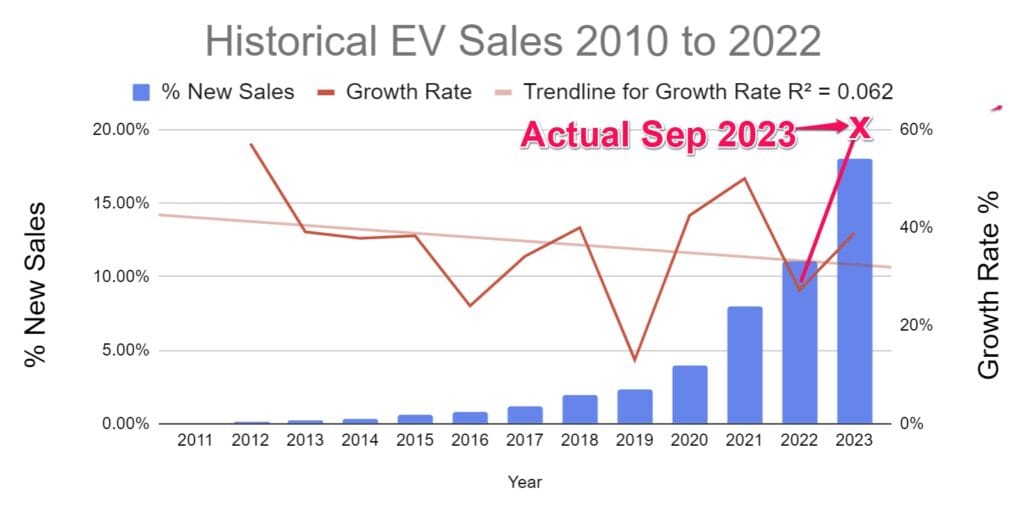The Rapid EV increase prediction by Prof Ray Wills from the Future Smart Strategies (also adjunct Professor at the University of Western Australia) is based on past data and details a concurrent rapid decrease of internal combustion engine cars (ICE). Electric cars and transportation is ever increasing and will reduce up to 25% of the world carbon emissions that have lead to climate change. Actual EV sales (20% in Sept 2023) exceed the conservative predictions by Bloomberg and IEA.
This following graph shows Prof Ray Wills predictions, I have superimposed Bloomberg numbers over the top (in blue). Why do we have such variance? Because Prof Wills says that change is exponential. As Tony Seba of RethinkX demonstrates is in book, the rise of a new technology creates a phase change disruption.

Rapid EV Increase Prediction Has History
World electric vehicle market share has increased exponentially, yet the IEA and Bloomberg NEF factor in that the rate of increase will dramatically decline, without specifying why such a rapid reduction would occur

The graph below shows that the growth rate is between 20% and 55% and that annual growth rate shows no slowing down. Is there a major reason why it should fall substantially? Even from 30% YOY? And the actual figure for Sept 2023 was 20% of all new cars.

Impact on Global Vehicles
- Global fleet of 1.5 billion vehicles fall to less than 550 million due to autonomous vehicles.
- Autonomous vehicles utilisation rises to 50%. The existing utilisation is 4% based on 15,000 km average travel per year.
- Oil demand falls by over 50%. Vehicle fuel accounts for 48% of all oil extracted. While oil for feedstock may rise, other uses will also fall with renewable energy pathways.

Why The Fall in ICE Cars?
The fall in ICE cars is entirely due to the rise in autonomous vehicles (Robotaxis)
What Value in Change from Self Ownership to Transport as a Service?
For a full reason explanation see the article Autonous Cars by 2023.
The societal benefit?

Destruction of Half of Current Oil Demand
Transportation accounts for 48.6% of oil demand for road transport. Other sector oil demand will further shrink oil demand – such as rail and domestic waterways, electricity, and residential


Australian Rise in EVs
New EV sales exceeded 8%. These are all sedans and SUVs. Note 20% of new vehicle sales are pickup trucks, and there is a limited selection of EV pickups. Pickups are coming.

Further Reading
- IEA Transport Outlook 2022 https://www.iea.org/energy-system/transport
- IEA Transport Outlook Update 2023 https://www.iea.org/reports/tracking-clean-energy-progress-2023
- Bloomberg NEF New Energy 2022 https://about.bnef.com/new-energy-outlook/
- Ray Wills Ted Talk https://www.youtube.com/watch?v=QmR_6QMCP0g









